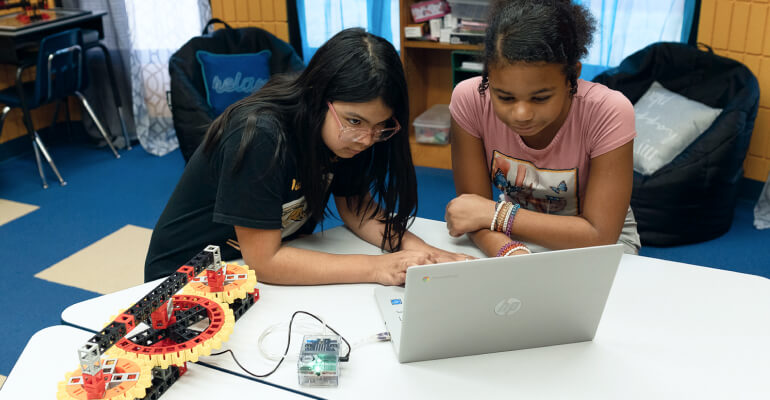Digital literacy is a crucial aspect of a strong STEM education, yet it’s not always addressed as a part of the curriculum. In fact, some educators may assume students are “digital natives” because of their generation, not realizing that digital literacy is a framework that must be taught.
In this article, we break down digital literacy as it relates to STEM education, including essential benefits, key definitions, and educational strategies.
What Is Digital Literacy?
According to the American Library Association’s Digital Literacy Task Force, the definition of digital literacy is “the ability to use information and communication technologies to find, evaluate, create, and communicate information, requiring both cognitive and technical skills.”
Digital literacy is more than the ability to use a computer or smartphone. Digital literacy includes the skills to engage with digital media and related technologies with a thoughtful perspective and an awareness of the ever-evolving digital landscape.
UNESCO features a more thorough definition of digital literacy, which says, “Digital literacy is the ability to access, manage, understand, integrate, communicate, evaluate and create information safely and appropriately through digital technologies for employment, decent jobs and entrepreneurship.”
Students who are digitally literate have the ability to use technology, including the internet, to find and evaluate information, judging the accuracy and reliability of that information. Students with strong digital literacy skills can communicate through this technology while also maintaining online safety and personal privacy.
What’s the Difference between Digital Literacy and Digital Fluency?
Digital literacy and digital fluency can be easily confused, but they are, in fact, different concepts. Digital literacy covers the use of technology effectively amidst the changing digital landscape. Digital fluency, however, goes a step further.
Digital fluency is the comprehensive understanding of technology in order to leverage those digital tools to solve complex problems and achieve specific goals. Digital fluency can be thought of as the next step after digital literacy.

Equity and Inclusion in Digital Literacy
The concept of digital literacy is closely tied to digital equity and digital inclusion. Education in the United States can look markedly different from classroom to classroom, with many students not given the resources and opportunities to gain the skills they need to succeed in higher education and future careers.
At Kid Spark Education, we prioritize equity in education, and we believe learning STEM is as important as learning how to read. Digital literacy is a crucial aspect of a complete STEM education.
In order to level the playing field when it comes to digital literacy, there are a few key definitions to know.
Digital Equity
According to the National Digital Inclusion Alliance, “Digital equity is a condition in which all individuals and communities have the information technology capacity needed for full participation in our society, democracy, and economy.”
Digital equity is about access to devices and services but also about the ability to successfully use those resources, navigating information safely and effectively. Digital equity grants “equal access to information, education, job opportunities, healthcare services, and civic engagement platforms,” according to the Internet Society Foundation.
Digital equity aligns with stem equity, which is the process of bringing equal access to quality STEM education to students of all socioeconomic and racial backgrounds. STEM has become a huge part of day-to-day life, appearing everywhere, from ordering our food to applying for a job. STEM inequity can set students behind their peers, which is why organizations like Kid Spark prioritize closing the STEM equity gap.
Digital Divide
The digital divide is “the gap between those who have affordable access, skills, and support to effectively engage online and those who do not,” as defined by the National Digital Inclusion Alliance.
The digital divide results in affected groups not having access to the three key Information and Communications Technologies (ICTs): internet connectivity, internet-accessible devices, and digital literacy skills.
The digital divide is most likely to affect already disadvantaged groups, including:
- Indigenous communities
- People in rural areas
- Minority communities
- Older people
- People with disabilities
- Low-income households
It can be easy to assume that the digital divide only occurs in countries outside of the United States, but that’s not the case. The digital divide is present in many communities across the county, often existing as an unaddressed issue.
Digital Inclusion
Digital inclusion is the effort to close the digital divide and bring digital equity to all communities. Digital inclusion consists of intentional strategies and initiatives that bridge the gap and provide long-term solutions and support for those people affected by digital inequity.
One element of digital inclusion is broadband adoption, which traditionally was the process of bringing high-speed internet access to residences. Today, broadband adoption includes the delivery of high-speed internet but also includes access to personal devices that are secure, alongside the digital literacy skills to use those devices effectively.
Digital inclusion can occur in schools as a part of STEM education and STEM equity programs. By incorporating a STEM education curriculum that features digital literacy skills, schools can help level the playing field at an early stage of life.

Pillars of Digital Literacy
The EU Science Hub defines five areas of digital competency in their DigComp Framework. Together, these pillars can give individuals the ability to interact successfully and responsibility with the ever-evolving digital landscape.
1. Information and Digital Literacy
This digital competency involves browsing digital content and knowing how to find and access the appropriate content. Individuals should be able to critically evaluate that digital content for credibility and relevance and then store and manage that data in a digital environment.
2. Communication and Collaboration
Digital technologies feature many different inbound and outbound communication methods, which someone with strong digital literacy skills should be able to navigate and utilize. Individuals should be able to collaborate with other individuals and organizations, particularly when it comes to seeking out and utilizing public and private services.
This pillar also includes the creation of a digital identity and management of digital citizenship. As a digital citizen, an individual should have proper “netiquette,” following appropriate behavioral norms and cultural sensitivities.
3. Digital Content Creation
Individuals with strong digital literacy skills should be able to create and share digital content while respecting appropriate copyright and licensing regulations.
4. Safety
Digital competency includes an understanding of the risks involved in interacting with the digital world. Individuals with digital competency should be able to understand how to protect their personal privacy and personal information as well as their software and devices. This concept of safety should extend to the social well-being of themselves and others, mitigating such dangers as cyberbullying.
5. Problem Solving
Individuals should be able to troubleshoot and solve technical problems, plus know when to bring in different digital tools. This problem solving can also expand outside of the digital environment to use digital tools to solve real-world problems, which is a common lesson in STEM education programs.

Digital Citizenship vs. Digital Literacy vs. STEM Literacy
Digital literacy is closely linked to other concepts, including digital citizenship and STEM literacy. Digital citizenship is “the responsible use of technology by anyone who uses computers, the internet, and digital devices to engage with society on any level.”
Thus, digital citizenship focuses on how individuals use technology to interact with society, doing so in a responsible manner. Digital literacy encompasses the skills that a good digital citizen would need to operate with today’s technology.
The definition of STEM literacy is the ability for individuals to understand and communicate about topics related to the subjects of science, technology, engineering, and mathematics in an effective way. STEM literacy and digital literacy skills are interlinked, and STEM educators should consider how they teach digital literacy skills as part of their STEM curriculum.
Benefits of Digital Literacy Education
Digital literacy skills are important for students to develop, with their benefits reaching beyond the classroom. Top benefits of digital literacy include:
- Preparing for the future workforce. In-demand STEM careers, as well as other career paths, require strong digital literacy skills.
- Increased classroom engagement. When students can connect with the material, like the digital content they enjoy in their free time, they’re more likely to apply themselves to the classroom material.
- Decreased risks for students. Students with strong digital literacy skills will be able to interact with the internet and digital platforms in a safe manner.
- New collaboration opportunities. Students and teachers can work together on digital platforms and even in between different classrooms and schools.
Digital Literacy and STEM Education
The “T” in STEM refers to technology, so digital literacy naturally integrates into that technological education. Digital literacy can go beyond a technology curriculum, though, as digital literacy can be utilized in engineering programs, science experiments, coding lessons, and more.
One example of digital literacy in a STEM program is with Kid Spark Education’s Robotics & Coding 101 for second through fifth grade students. In this unit of study, students begin creating a series of basic programs that are uploaded to the Kid Spark Spark:bit robotics controller. Through several hands-on projects, students begin to focus on foundational principles of coding and robotics. Emphasizing digital literacy, using cognitive skills, critical thinking, creativity, and problem solving skills.
Students will be introduced to a new interface in MakeCode where they will learn about coding and robotics. They will utilize their digital literacy skills to become familiar with the platform and troubleshoot their assignment.
Build Digital Literacy in STEM Education with Kid Spark Education
The need for strong digital literacy skills isn’t going away—it’s only becoming more important. These digital literacy skills coexist with STEM education, and STEM educators can benefit hugely by consciously including digital literacy education into their classroom.
At Kid Spark Education, we believe in closing the equity gap in STEM education, including in those digital literacy competencies. Our programs give students the skills they need to succeed in STEM both in the classroom and in their futures.
Create a free account to explore the STEM curriculum, or contact our team today to learn more about our programs.
.png?width=1270&height=453&name=Copy%20of%20Kid%20Spark%20Logo%20(Horizontal%20-%20Full%20Color).png)